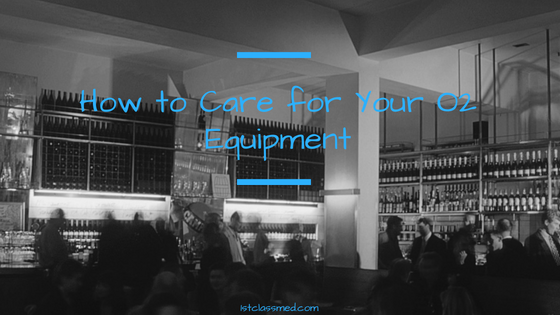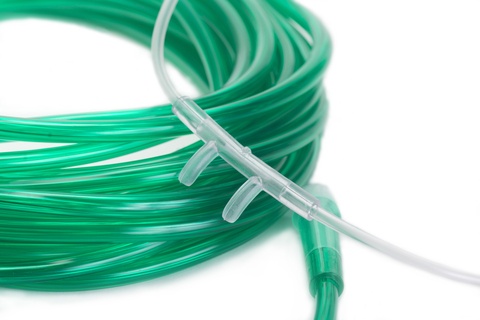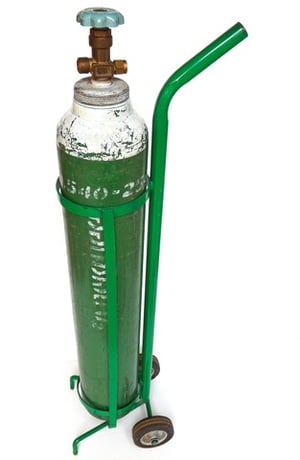
It may seem like your O2 equipment should be clean, as it only makes contact with oxygen, but it can get dirty easily and can end up causing infections.
It is important to take care of your supply of oxygen, as treating it poorly can end up requiring your to purchase new equipment.
Liquid oxygen, compressed oxygen and oxygen concentrators all require minimal care, but it can help keep the unit working longer.
For those on supplemental oxygen, nasal cannula and masks are helpful ways to get oxygen directly to your lungs.
Both cannula and masks should be switched out every 2 to 4 weeks, but should be cleaned every week.
It is also important to have back up cannula and masks in case one is to tear or break, or if you need to clean your current one.
How to Clean Cannula or Masks:

When cleaning your cannula or mask, it is important to make sure you clean it in warm, soapy water.
Soap should be mild scented, so when you reattach it to your equipment, you do not smell the soap and trigger a flare up.
A good way to kill chemicals is to use ten parts water and one part vinegar after washing with soap, as the vinegar will kill any bacteria.
After you rinse the cannula or mask with the vinegar mix, it is important to rinse with hot water and hang it to dry for later use.
Maintenance of Your Oxygen Tubing:
It is important to maintain your oxygen tubing in order to keep them working longer.
Tubing averages between 25-50 feet, any longer can prevent oxygen from getting to your airways.
Though cannula and masks should be cleaned often, tubing does not need to be cleaned.
You do need to replace tubing when you see cracks or wear and tear, but otherwise it only needs to be replaced twice a year.
Maintenance of Humidifier Bottles:
For many people, the continuous flow of oxygen can dry out the nasal passages, causing bleeding and open wounds that can lead to possible infections.
A humidifier bottle may be used in order to help prevent a dry nose, and infection.
Like nasal cannula and masks, humidifier bottles should be cleaned with warm, (mild scented) soapy water.
It is also important to soak in 10-parts water and 1-part vinegar in order to kill off any remaining bacteria or germs.
Finally rinse with hot water and let dry, this will remove any remaining soap or vinegar.
Make sure to only use distilled water, which can be purchased in gallon jugs at any grocery store.
O2 Equipment:
Liquid Oxygen:
Unlike other oxygen supply sources, liquid oxygen comes cold and is warmed before you breathe it in.
Liquid oxygen is not allowed aboard commercial airlines, as the cabin pressure and the pressure on the oxygen can cause an explosion.
There are many different components to a liquid oxygen container, the content indicator, flow meter, humidifier bottle, and filling connector.
The contents indicator tells you the amount of oxygen remaining in the container, there is not much needed in order to maintain and care for this part of the container.
The flow meter controls the flow of oxygen and how quickly it comes out of the container this also does not require much maintenance.
Humidifier bottles do need to be cleaned out but following the above cleaning steps can help keep it clean and as good as new.
Not everyone needs a humidifier bottle, it all depends on the flow rate required by the user and the area they live in.
Lastly, the filling connector is used to fill a portable unit with liquid oxygen from a stationary unit and does not require any maintenance.
Basic maintenance would include taking care of the machine, wiping it down and cleaning the cannula and tubing as needed.
It is very important to clean any valve opening or tubing outlet to prevent any dirt or germs come into contact with the oxygen.
Oxygen Tank:
Oxygen tanks are heavy metal tanks that are filled with compressed oxygen, but cannot be brought onto airplanes as they too can cause an explosion aboard the flight.
Like liquid oxygen, there are a few different components to an oxygen tank, including a pressure gauge, flow meter and humidifier bottle.
The pressure gauge lets the user know how much oxygen is remaining in the tank, this does not need to be cleaned.
The flow meter controls how quick the oxygen comes out of the tank, this also does not need to be maintained.
The humidifier bottle allows moisture to be added to the oxygen (to help protected the nose from getting too dry), it is often warmed before you breathe in the moistened air.
It is not always required for the oxygen user to have a humidifier bottle, as the flow rate may not be high enough to need the bottle.
By cleaning the bottle with the method above, it can help prevent bacteria and germs from growing and possibly cause an infection in the oxygen user.
Oxygen Concentrator:
Oxygen concentrators take the outside air and removes everything except oxygen (such as nitrogen or other impurities in the air).
Oxygen concentrators are able to be brought onto planes as they are not compressed and do not pose a risk of explosion.
There are a few components to oxygen concentrators, such as the power switch, flow meter, alarm buzzer and a humidifier bottle.
The power switch is just that, a switch that turns on and off the machine, there is normally a light that accompanies the switch to let the user know if it is on or not.
If the light does not work, or the unit does not turn on or off, contact customer service that you purchased the product from and discuss what can be done or what could be wrong.
A flow meter is used to control how fast the oxygen comes out of the concentrator, this does not need to be cleaned.
An alarm buzzer is a signal that goes off if the unit were to turn off for any reason, if this goes off, contact customer service from where you bought the concentrator, or there may be a number to call that is listed on the unit itself.
The humidifier bottle, like liquid oxygen and concentrated oxygen, is not always required to be used, depending on the flow of air your body requires.
No matter what form of oxygen you receive, it is important to clean the unit as needed and follow the above cleaning method to prevent any growth of bacteria.
Caring for Yourself with O2 Equipment:
Many oxygen supply sources require cannula or a mask in order to get the oxygen from the machine to your nose, this cannula can cause irritation to the skin.
Make sure to add padding such as cotton balls or cotton pads where you feel irritation on the skin, this can prevent rashes or blisters.
If you feel that your unit it too heavy, you can look into wheeling carts or carrying bags to make transportation of you and your equipment easier and safer.
It is also important to speak with your doctor if you have any issues with your unit, or how it is used, as your doctor may be able to find alternatives for you.



